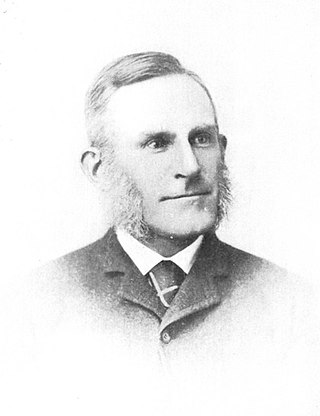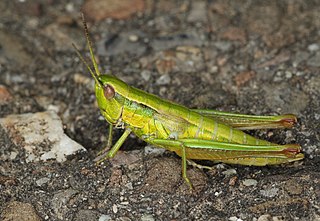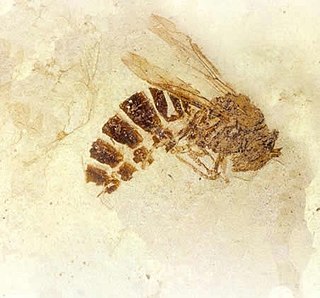
The Nymphalinae are a subfamily of brush-footed butterflies. Sometimes, the subfamilies Limenitidinae, and Biblidinae are included here as subordinate tribe(s), while the tribe Melitaeini is occasionally regarded as a distinct subfamily.

Hesperia, the branded skippers, is a Holarctic genus in the skippers (Hesperiidae) butterfly family. Most species are endemic to North America, Hesperia comma is widespread throughout the region. H. florinda is endemic to temperate eastern Asia. H. nabokovi is endemic to Hispaniola.

Samuel Hubbard Scudder was an American entomologist and paleontologist. He was a leading figure in entomology during his lifetime and the founder of insect paleontology in America. In addition to fossil insects, he was an authority on butterflies (Lepidoptera) and grasshoppers (Orthoptera).

Buprestis is a genus of beetles in the tribe Buprestini, the jewel beetles. As of 2011 there were 78 described species distributed across most of the world's biogeographic realms except parts of Africa and Antarctica.

Erora is a genus of butterflies in the family Lycaenidae erected by Samuel Hubbard Scudder in 1872. The species of this genus are found in the Nearctic and Neotropical realms.

Speyeria, commonly known as greater fritillaries, is a genus of butterflies in the family Nymphalidae commonly found in North America, Europe, and Asia. Some authors used to consider this taxon a subgenus of Argynnis, but it has been reestablished as a separate genus in 2017.

Daseochaeta is a genus of moths of the family Noctuidae. The genus was described by Warren in 1907.
Pamphilites is an extinct genus of skippers in the family Hesperiidae. It contains only one fossil species, Pamphilites abdita, recovered from the Tertiary of Aix-en-Provence, France.

Cercopidae are the largest family of Cercopoidea, a xylem-feeding insect group, commonly called froghoppers or spittlebugs. They belong to the hemipteran suborder Auchenorrhyncha. A 2023 phylogenetic study of the family suggested the elevation of subfamily Ischnorhininae to full family status as Ischnorhinidae, leaving a monophyletic Cercopinae.

Gomphocerinae, sometimes called "slant-faced grasshoppers", are a subfamily of grasshoppers found on every continent but Antarctica and Australia.

Prodryas persephone is an extinct species of brush-footed butterfly, known from a single specimen from the Chadronian-aged Florissant Shale Lagerstätte of Late Eocene Colorado. P. persephone is the first fossil butterfly to be found in North America, and is exquisitely well preserved. Its closest extant relatives are the mapwings and African admirals of the genera Hypanartia and Antanartia, respectively.

Palaeovespa is an extinct genus of wasp in the Vespidae subfamily Vespinae. The genus currently contains eight species, five from the Priabonian stage Florissant Formation in Colorado, United States two from the middle Eocene Baltic amber deposits of Europe. and one species from the late Paleocene of France.
Anthidium scudderi is an extinct species of mason bee in the Megachilidae genus Anthidium. The species is solely known from the late Eocene, Chadronian stage, Florissant Formation deposits in Florissant, Colorado, USA. Anthidium scudderi is one of only four extinct species of mason bees known from the fossil record, and with Anthidium exhumatum, one of two species from the Florissant Formation.
Anthidium exhumatum is an extinct species of mason bee in the Megachilidae genus Anthidium. The species is solely known from the late Eocene, Chadronian stage, Florissant Formation deposits in Florissant, Colorado, USA. Anthidium exhumatum is one of only four extinct species of mason bees known from the fossil record, and with Anthidium scudderi, one of two species from the Florissant Formation.

Prehistoric Lepidoptera are both butterflies and moths that lived before recorded history. The fossil record for Lepidoptera is lacking in comparison to other winged species, and tending not to be as common as some other insects in the habitats that are most conducive to fossilization, such as lakes and ponds, and their juvenile stage has only the head capsule as a hard part that might be preserved. Yet there are fossils, some preserved in amber and some in very fine sediments. Leaf mines are also seen in fossil leaves, although the interpretation of them is tricky. Putative fossil stem group representatives of Amphiesmenoptera are known from the Triassic.

Lithopsyche is a fossil butterfly known from Oligocene-aged strata of the Isle of Wight, England. The sole specimen is too incomplete to allow a certain assignment of a family, but it was placed on its description as a geometrid and more recently in the Riodininae.
Protostephanus is an extinct genus of crown wasp in the Hymenoptera family Stephanidae known from an Eocene fossil found in the United States of America. The genus contains a single described species, Protostephanus ashmeadi placed in the stephanid subfamily Stephaninae.

Phryganea is a genus of giant caddisflies in the family Phryganeidae. There are about 13 described species in the genus.

Campylacantha is a genus of spur-throated grasshoppers in the family Acrididae. There are about five described species in Campylacantha.

Palaeorehniidae is an extinct family of katydid-like orthopterans that has been described from the fossil record. The family is known from the Paleocene to the end of the Eocene and has been described from North America and Scotland. Circumscription and placement of the group has changed several times since it was first described in 1939, with the group currently treated as a family that is incertae sedis in the suborder Ensifera. Five monotypic genera are assigned to the family.















